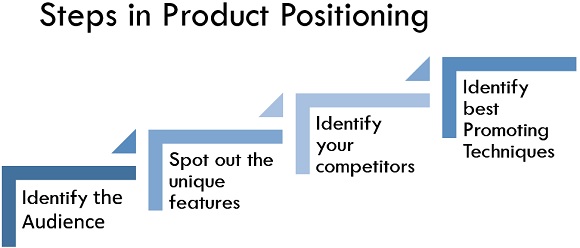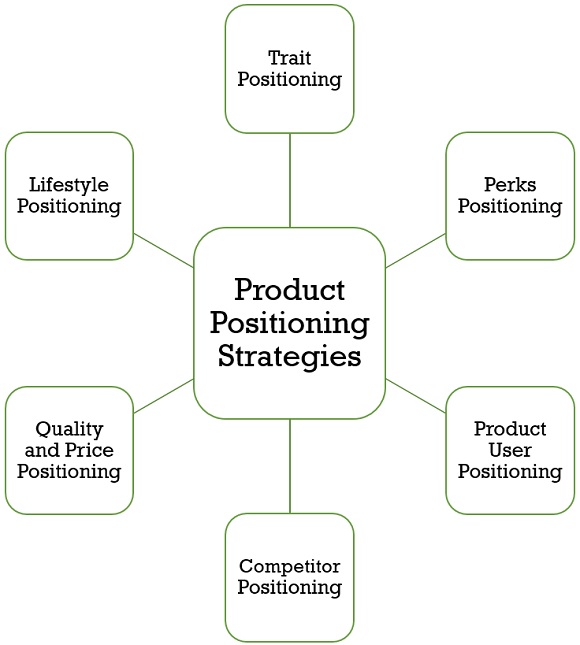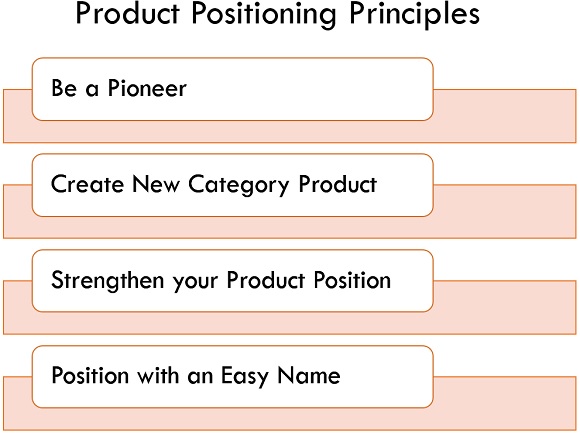Definition: Product positioning is the image formation of the product’s in the intended customers’ minds against their competitors in the same market. A good product positioning impact should result in like if the customer thinks of a product, the image that comes in his/her mind should be of your product. It builds gradually with the customer’s past experiences with your product and its quality.
Let us take an example of a noodle company “Maggie”. It has created such a distinctive image in customers’ minds that whenever the word noodle comes, the name “Maggie” automatically comes in the mind of the customer. This type of image of the product increases the demand for a product in the market and creates a loyal customer group of your product.
Content: Product Positioning
Steps in Product Positioning
The steps that should be followed in the process of product positioning are as follows:

Identify the Audience
The foremost step in the product positioning should be identifying the audience or consumer group and knowing their needs.
Spot out the unique features of your product
For making the consumer’s trust over your product and serve the best product to them, the company itself should know special and unique features of its products and should analyse the strengths of their product which encourages the consumers to buy your product from the whole market.
Identify your competitors
Producing a product is not enough for establishing a place in the market; the company must have to keep an eye on its competitors to understand their strategies to survive in the market. It also helps in making companies own strategies considering the strengths and weaknesses of their competitors.
Identify best Promoting Techniques
Promoting techniques plays a very important role in product positioning. There is a very famous quote ‘Jo dikhta hai wahi bikta hai’. Thus, the company should choose efficient advertisement channels for promoting their product showing the benefits of your product.
Product Positioning Strategies
Following are some of the strategies of product positioning:

1. Trait Positioning: In this type of positioning, the marketer creates an image of a product in the consumer’s mind on the basis of unique quality or features of their products. For example, A toothpaste brand Colgate uses a tagline “Kya apke toothpaste mai namak hai” to emphasise on their product’s unique feature of active salt ingredient.
2. Perks Positioning: This strategy of product positioning focuses on the benefits provided by the companies to its customers by using their product or service. One of the best examples of serving this type of positioning is “LIC ” which provides the tagline “Zindagi ke saath bhi zindagi ke baad bhi”.
Here, they explain with their tagline that their services will benefit the user when they were alive and will benefit their family after their death.
3. Product User Positioning: After spotting the targeted customer group positioning for suitable products is done according to the customers’ needs and demands. One of the examples of this type of positioning is the introduction of another variant of the Horlicks company targeting women’s group of consumers, i.e., “Women’s Horlicks” with a bone nutrients formula.
However, Horlicks is an old company serving its product for the children group of the customer with a famous tagline “Taller, Stronger and sharper”.
4. Competitor Positioning: This type of strategy is applied when the company wants to compete with the leading company selling a similar line product and wants to demolish them. They spend a huge amount on advertising their products and introducing new technologies in the market.
Let us take an example of Nokia and Samsung. There was a time when Nokia used to capture almost 80-90% market of mobile phones. However, with the introduction of android phones in the market, Samsung gradually captured its market and uprooted them from the market.
5. Quality and Price Positioning: Quality and price positioning is done by keeping consumer’s expectations of quality and price in the mind while making a positioning strategy to provide them with the quality product in an efficient price. One of the best examples of this type of positioning is the “Fastrack watches” which is also a sub-brand of titan watches but introduces a quality product at an affordable price.
This type of positioning increases the customer’s trust in your brand.
6. Lifestyle Positioning: Companies producing the products that are not necessities but are used to enhance the consumers’ lifestyle uses such type of positioning strategy. With a modern lifestyle, consumers use various products just for convenience such as microwave, cars, etc.
Product Positioning Principles
Following are some of the principles that should be kept in mind by the company while making product positioning decisions:

- Be a Pioneer
It is always beneficial for the company to be a pioneer of a product. The consumer always remembers the product with the name of a pioneer company of a product. The best example of it is “McDonald’s”. Whenever anyone thinks of buying a burger, the very first name that comes in mind is McDonald’s (pioneer company of serving burger).
- Create New Category Product
If the company is not a pioneer of a product, try to create a new category product with some changes and then introduce it in a market with its exclusive features and benefits in comparison to the competitors.
- Strengthen your Product Position
Creating a position in the minds of the consumers in the market full of competition is very tough. However, providing some extra advantages to the customer helps strengthen your product’s position in the consumers’ minds.
- Position with an Easy Name
Positioning of a product should always be done with an easy name so that the consumer can easily pronounce and search for a product, as easy name stays for a longer period of time in the mind of the consumers.
Leave a Reply